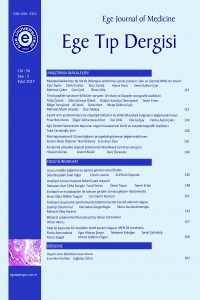Abstract
Rhabdomyolysis is a clinical syndrome characterized by muscle necrosis and the release of intracellular muscle ingredients into the blood circulation. The most serious complication is acute kidney injury. Rhabdomyolysis may occur due to various etiological factors. The most common reasons are crush injuries to muscle, excessive exercise, inflammatory muscle diseases, prolonged immobility, electrolyte imbalances and drug toxicity. The clinicians should be aware for rhabdomyolysis and its possible complications in drug poisoning cases. Enalapril may cause electrolyte imbalance and escitalopram may cause serotonin syndrome resulting rhabdomyolysis. In this paper we present a previously healthy fifteen years old girl, who developed rhabdomyolysis without electrolyte imbalance or neuroleptic syndrome after intake of enalapril and escitalopram for suicide attempt. A large number of drugs can cause rhabdomyolysis by different mechanisms. It should be kept in mind that the some drugs can cause rhabdomyolysis without causing significant clinical changes.
Keywords
References
- Melli G, Chaudhry V, Cornblath DR. Rhabdomyolysis: An evaluation of 475 hospitalized patients. Medicine 2005;84(6):377-85.
- Huerta-Alardin AL, Varon J, Marik PE. Rhabdomyolysis an overview for clinicians. Crit Care 2005;9(2):158-69.
- Giannoglou GD, Chatzizisis YS, Misirli G. The syndrome of rhabdomyolysis: Pathophysiology and diagnosis. Eur J Intern Med 2007;18(2):90-100.
- Al-Ismaili Z, Piccioni M, Zappitelli M. Rhabdomyolysis: Pathogenesis of renal injury and management. Pediatr Nephrol 2011;26(10):1781-8.
- Elsayed EF, Reilly RF. Rhabdomyolysis: A review, with emphasis on the pediatric population. Pediatr Nephrol 2010;25(1):7-18.
- Watanabe T. Rhabdomyolysis and acute renal failure in children. Pediatr Nephrol 2001;16(12):1072-5.
- Luck RP, Verbin S. Rhabdomyolysis: A review of clinical presentation, etiology, diagnosis, and management. Pediatr Emerg Care 2008;24(4):262-8.
- Mannix R, Tan ML, Wright R, Baskin M. Acute pediatric rhabdomyolysis: Causes and rates of renal failure. Pediatrics 2006;118(5):2119-25.
- Veenstra J, Smit WM, Krediet RT, Arisz L. Relationship between elevated creatine phosphokinase and the clinical spectrum of rhabdomyolysis. Nephrol Dial Transplant 1994;9(6):637-41.
- Oshima Y. Characteristics of drug-associated rhabdomyolysis: Analysis of 8,610 cases reported to the U.S. Food and Drug Administration. Intern Med 2011;50(8):845-53.
Abstract
Keywords
References
- Melli G, Chaudhry V, Cornblath DR. Rhabdomyolysis: An evaluation of 475 hospitalized patients. Medicine 2005;84(6):377-85.
- Huerta-Alardin AL, Varon J, Marik PE. Rhabdomyolysis an overview for clinicians. Crit Care 2005;9(2):158-69.
- Giannoglou GD, Chatzizisis YS, Misirli G. The syndrome of rhabdomyolysis: Pathophysiology and diagnosis. Eur J Intern Med 2007;18(2):90-100.
- Al-Ismaili Z, Piccioni M, Zappitelli M. Rhabdomyolysis: Pathogenesis of renal injury and management. Pediatr Nephrol 2011;26(10):1781-8.
- Elsayed EF, Reilly RF. Rhabdomyolysis: A review, with emphasis on the pediatric population. Pediatr Nephrol 2010;25(1):7-18.
- Watanabe T. Rhabdomyolysis and acute renal failure in children. Pediatr Nephrol 2001;16(12):1072-5.
- Luck RP, Verbin S. Rhabdomyolysis: A review of clinical presentation, etiology, diagnosis, and management. Pediatr Emerg Care 2008;24(4):262-8.
- Mannix R, Tan ML, Wright R, Baskin M. Acute pediatric rhabdomyolysis: Causes and rates of renal failure. Pediatrics 2006;118(5):2119-25.
- Veenstra J, Smit WM, Krediet RT, Arisz L. Relationship between elevated creatine phosphokinase and the clinical spectrum of rhabdomyolysis. Nephrol Dial Transplant 1994;9(6):637-41.
- Oshima Y. Characteristics of drug-associated rhabdomyolysis: Analysis of 8,610 cases reported to the U.S. Food and Drug Administration. Intern Med 2011;50(8):845-53.
Details
| Primary Language | Turkish |
|---|---|
| Subjects | Health Care Administration |
| Journal Section | Case Report |
| Authors | |
| Publication Date | September 1, 2017 |
| Submission Date | June 26, 2016 |
| Published in Issue | Year 2017 Volume: 56 Issue: 3 |
Ege Journal of Medicine enables the sharing of articles according to the Attribution-Non-Commercial-Share Alike 4.0 International (CC BY-NC-SA 4.0) license.

